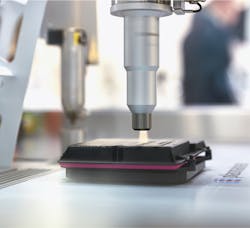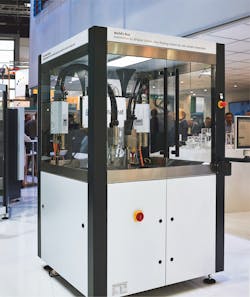OEM Redesigns Equipment to Incorporate XPlanar Floating Movers
I first saw the XPlanar system from Beckhoff on display a few years ago at the Smart Production Systems event in Nuremberg, Germany, not long after it had been introduced for use in Europe. The system was not yet available in the U.S., but that changed this past fall when XPlanar made its U.S. debut at the PACK EXPO Connects event. (See a video report on XPlanar stemming from its introduction at the PACK EXPO event).
As interesting as I found the technology after first seeing it in Nuremberg, the real test of any new technology is in its application. Though a number of companies have been using the technology since its introduction in Europe, we are now able to report on Plasmatreat’s use of XPlanar to transport workpieces in the company’s plasma pretreatment processes.
Plasmatreat is a global company based in Steinhagen, Germany, that manufactures plasma systems for high-efficiency surface treatment and environmentally friendly production processes.
If you’re unfamiliar with plasma pretreating, Plasmatreat explains it as a key technology for microfine cleaning, surface activation, and plasma coating of numerous kinds of materials—from plastics, metals, and glass to cardboard, textiles, and composites. Common applications of plasma pretreating include: in the automotive industry for headlights and other interior and exterior parts; in electronics for printed circuit boards and smartphones; in packaging for board, paper, glass, and metal materials; in consumer goods for appliances, furniture, and sporting goods; and in life sciences for disinfection and surface treatment.
It’s in these stages where Plasmatreat is using XPlanar in one of its new plasma treatment machines. In this new machine, XPlanar replaces prior systems used to move workpieces and eliminates the need for six-axis robots and linear motors.
“We wanted a fast, fully programmable, wear-free system to transport the workpieces,” said Stichling. “And when it came to custom-programming of tracks and travel, there was no real alternative to XPlanar.”
XPlanar explained
According to Jeff Johnson, U.S. Mechatronics Product Manager at Beckhoff, the XPlanar system consists of planar tiles that can be arranged in any pattern, combined with contactless movers that float over them and provide fast, flexible, and precise positioning. The movers operate jerk-free and are capable of traveling at speeds of up to 2 m/s, accelerating at 2 g, and being positioned with a repeatability of 50 µm.
Because these jets are mechanically and electrically complex, the ability to move the workpieces with XPlanar, rather than moving the plasma jets themselves, reduces wear to the jets’ feed lines.
Johnson explained that Xplanar is capable of doing this “silently and without wear or abrasion. The system not only supports movement within the x-y space, but it also provides additional functions to allow mover positioning with up to six degrees of freedom to raise and lower tiles up to 5 mm (when unloaded), with weighing capabilities available as an option; tilt up to 5° when transporting and handling liquids; and rotate 360°.”
The XPlanar system in the Plasmatreat machine consists of six 240x240mm planar tiles and a single planar mover.
Pretreatment redesign
Johnson noted that it took less than two months to integrate the XPlanar system into Plasmatreat’s machine because Beckhoff was able to quickly supply the 3D data and the electrical connection information, enabling Plasmatreat to incorporate the XPlanar starter kit into its machine design.
Implementing XPlanar in its pretreating system allowed Plasmatreat to eliminate the need for plasma jets to be moved over the material to be treated. Because these jets are mechanically and electrically complex, the ability to move the workpieces with XPlanar, rather than moving the plasma jets themselves, reduces wear to the jets’ feed lines.
Another benefit, according to Stichling, is that “a variety of material samples can be attached to the mover for treatment using simple adapters. We can easily add processing stations alongside the plasma jets—markers for good parts, for instance, or optical sensing heads to conduct full part inspections—and carry workpieces to them flexibly as needed. And XPlanar’s rapid acceleration also lets us move material samples at high speeds. With thin samples, for instance, this helps minimize treatment time with the fixed jet.”
Explaining the difference in plasma pretreating before and after XPlanar, Stichling said, “Conventional [plasma pretreatment] setups use a six-axis robot or linear motors to move a plasma jet around a stationary workpiece. From a cost perspective, XPlanar comes in somewhere between linear-axis and robotic systems. With flat parts that don’t require much vertical travel on the z-axis, [an application] where robotic systems are usually ideal, XPlanar offers an excellent alternative to gantry-type systems. XPlanar’s advantages in terms of lack of wear, easy cleaning, and clean-room compatibility also play out here.”
Considering the success Plasmatreat has had incorporating XPlanar into its equipment so far, Stichling noted that XPlanar “has the potential to optimize plasma surface treatment in two key areas: direct integration of in-line testing for full inspections during the treatment process, and custom-programmable mover travel routes for end customers.”
About the Author
David Greenfield, editor in chief
Editor in Chief

Leaders relevant to this article:


